Science’s problem with microplastics
Researchers use single-use plastic products like pipettes and minifigs daily, contributing to pollution that won’t break down for centuries, writes Alice Bell
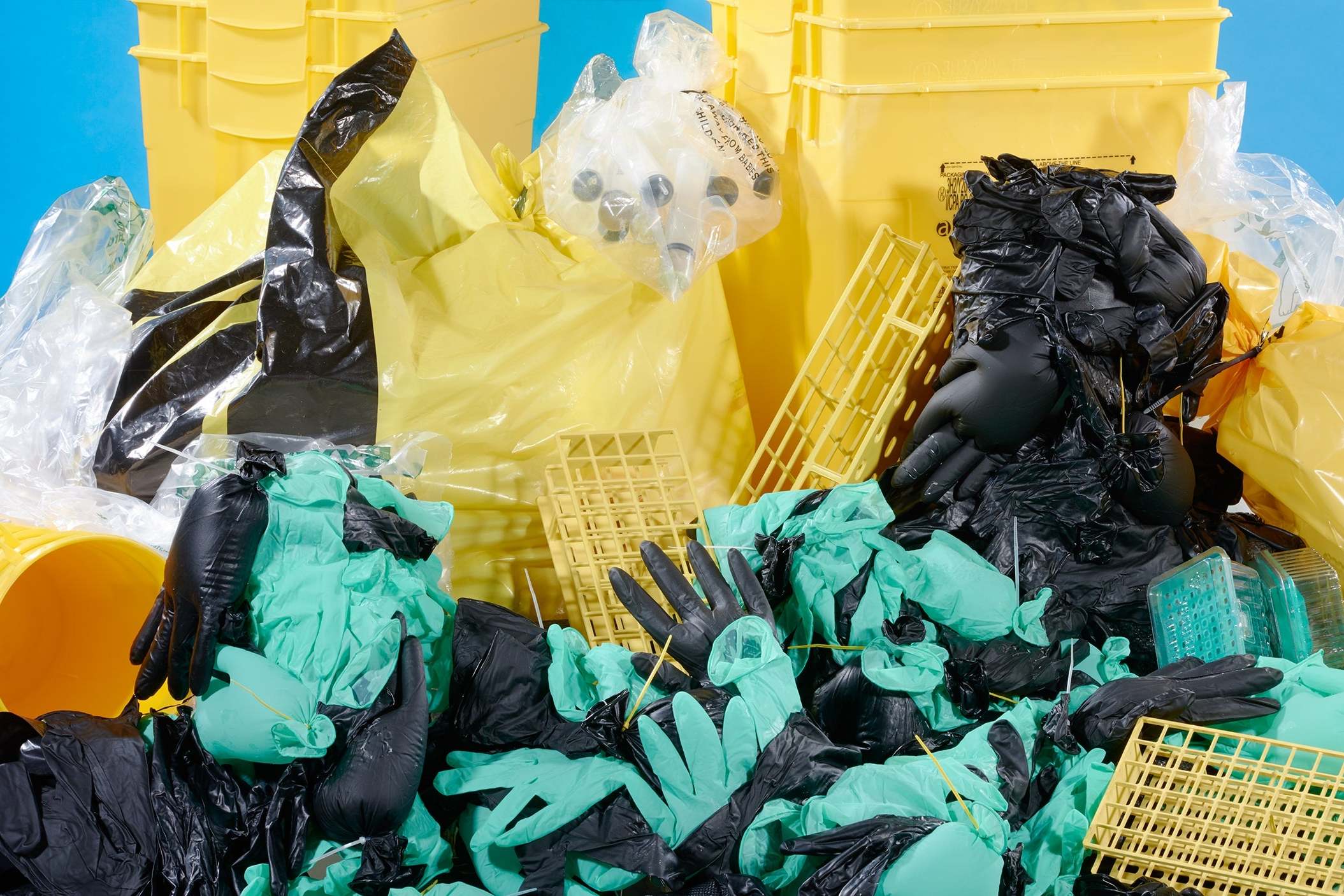
Your support helps us to tell the story
From reproductive rights to climate change to Big Tech, The Independent is on the ground when the story is developing. Whether it's investigating the financials of Elon Musk's pro-Trump PAC or producing our latest documentary, 'The A Word', which shines a light on the American women fighting for reproductive rights, we know how important it is to parse out the facts from the messaging.
At such a critical moment in US history, we need reporters on the ground. Your donation allows us to keep sending journalists to speak to both sides of the story.
The Independent is trusted by Americans across the entire political spectrum. And unlike many other quality news outlets, we choose not to lock Americans out of our reporting and analysis with paywalls. We believe quality journalism should be available to everyone, paid for by those who can afford it.
Your support makes all the difference.Lucy Gilliam has an infectious passion for environmental action. Today she works in Brussels on environmental transport policy. But in the early 2000s she was a molecular microbiologist in Hertfordshire. Like many in her field, Gilliam got through a lot of disposable plastics. It had become a normal part of 21st-century science, as everyday as coffee and overtime.
Gilliam was, in her words, a “super high user” of the sort of plastic, ultra-sterilised filter pipettes that could only be used once. Just as so many of us do in our domestic lives, she found she was working with what anti-pollution campaigners call a “produce, use, discard” model. The pipettes would pile up, and all that plastic waste just seemed wrong to her.
Science’s environmental impact had begun to worry her. It wasn’t just a matter of plastics. She also wanted to know why there weren’t solar panels on the roof of the new lab building, for example, and why flying to conferences was seen more as a perk than a problem. “I used to bitch about it over coffee all the time,” Gilliam says. “How can it be that we’re researching climate science, and people are flying all over the place? We should be a beacon.”
She tried to initiate recycling programmes, with some success. She invited the suppliers in to discuss the issue, and worked out ways the research teams could at least return the boxes pipettes came in for reuse, even if the pipettes themselves would still be used and discarded. It felt like a battle, though. Sensing that progress was likely to be slow, she started to ask herself where exactly she could make change happen, and moved to work in environmental policy.
Scientific research is one of the more hidden users of disposable plastics, with the biomedical sciences a particularly high-volume offender. Plastic petri dishes, bottles of various shapes and sizes, several types of glove, a dizzying array of pipettes and pipette tips, a hoard of sample tubes and vials. They have all become an everyday part of scientific research. Most of us will never even see such equipment, but we all still rely on it. Without it, we wouldn’t have the knowledge, technologies, products and medicines we all use. It is vital to 21st-century lives, but it is also extremely polluting.
How can it be that we’re researching climate science, and people are flying all over the place? We should be a beacon
In 2015 researchers at the University of Exeter weighed up their bioscience department’s annual plastic waste, and extrapolated that biomedical and agricultural labs worldwide could be responsible for 5.5 million tonnes of lab plastic waste a year. To put that in context, they pointed out it’s equal to 83 per cent of the plastic recycled worldwide in 2012.
The problem with plastic is that it is so durable; it won’t decompose. We throw it in the rubbish, it stays there. It is thought that there may now be more Lego people on Earth than actual people, and these minifigs will outlive us all. When plastic products like these minifigs – or pipettes, bottles or drinking straws – do eventually break down, they stick around as small, almost invisible fragments called microplastics, which also come from cosmetics and clothing fibres.
A 2017 study found microplastics in 81 per cent of tap water samples globally. In the past few years, in mountain ranges in the US and France, researchers even found microplastics in rain. They have recently been found in the Arctic, too.
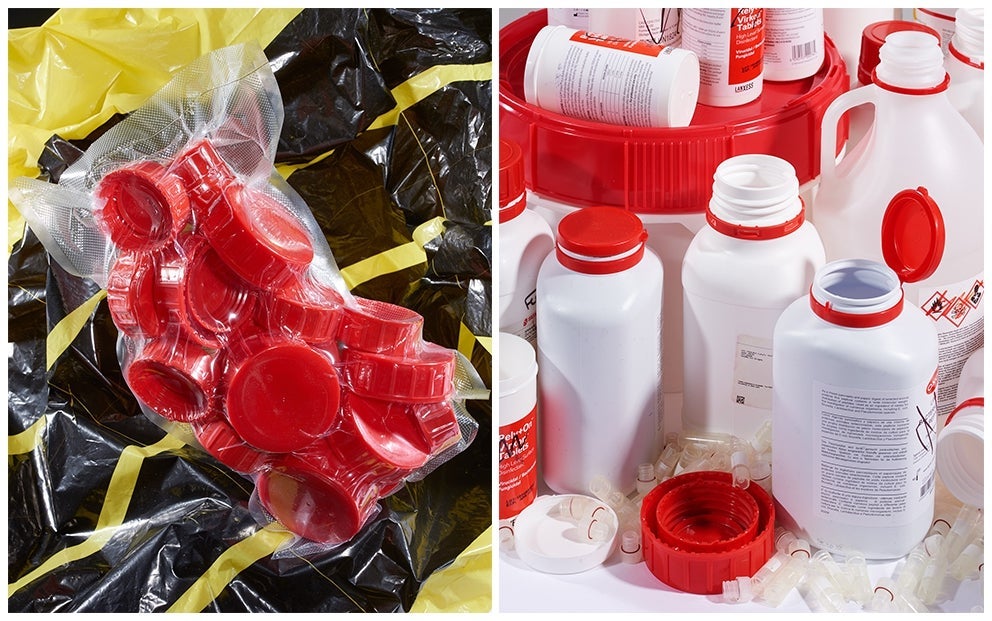
Modern science has grown up with disposable plastics, but times are changing. This autumn, the first wave of young people to follow the Swedish climate activist Greta Thunberg and go on “school strike for the climate” started undergraduate degrees. Universities can expect these young people to bring fresh and sometimes challenging questions about how scientific research is conducted. At the same time, many of those from Generation Z (those born from the mid-1990s onwards) are now starting PhDs, and millennials (born from the early 1980s) are leading more and more labs. As more universities challenge themselves to eradicate disposable plastics, as well as to go zero-carbon, in the next few years or decades, scientific waste is increasingly being put under the microscope.
* * *
In a sign of how far things have moved on since Gilliam left her career in research, last November the University of Leeds pledged to go single-use-plastic-free by 2023. Recently UCL has announced it will follow suit, with the only slightly less ambitious target of 2024. These new policies won’t just banish disposable coffee cups from campus, but a lot of everyday scientific equipment too.
Lucy Stuart, sustainability project officer at Leeds, says that reaction among researchers has been mixed, but they are gradually making progress. “For us, as a university, we are here to inspire the next generation,” she says. “Also, we are a research-based institution that is creating groundbreaking innovation every day, so we didn’t want to say the solutions aren’t possible, because we are the people that help create those solutions.”
The ambitious target has helped focus everyone’s attention, as has the clear sign that it has support all the way through the institution from the top of university management down. However, “we don’t want to implement top-down policies”, Stuart emphasises. “We want individual researchers and employees to take ownership and look at the problem within their area, and then make a change.”
We want individual researchers and employees to take ownership and look at the problem within their area, and then make a change
Elsewhere, many scientists are already pushing ahead on their own initiative. When David Kuntin, a biomedical researcher at the University of York, was discussing plastic waste with his lab mates, he soon found he wasn’t the only one who had noticed how much they were getting through.
“Using plastics on a daily basis – in science, it is kind of impossible to avoid nowadays. And someone just said, ‘Oh, we could fill a room after a week!’ and it got us discussing what we could do.”

One reason lab plastics are such a sticky problem is that they can get contaminated with the biological or chemical matter being researched: you can’t simply put them in the campus recycling bins with your coffee cup. Usually, lab waste plastics are bagged and autoclaved – an energy- and water-hungry sterilisation process – before being sent to landfill. But, Kuntin says, not all plastic waste is too contaminated to recycle. Rather than simply classing everything as hazardous, straight off, he and his colleagues did an audit of the plastic they used, to see what they could decontaminate.
“The contamination we deal with is probably less dangerous than a mouldy tin of beans you might have in your recycling after a few weeks,” Kuntin says. So, just as the team had learned that they had to wash their tins of beans before they put them in the council recycling bin, they learned ways to decontaminate their lab waste, too.
They developed a “decontamination station” with a 24-hour soak in a high-level disinfectant, followed by a rinse for chemical decontamination. They also looked at the plastics they were buying, to pick ones that would be easier to recycle. As a result of these measures, they’ve reduced the plastic they were previously sending to landfill by about a tonne a year.
“That’s 20 workers, 20 of us,” he says, sounding as if he still doesn’t quite believe that so few researchers could pile up so much waste. “We used a tonne of plastic that we can recycle.” They worked out it was enough to fill 110 bathtubs. And because they have also cut down how much equipment has to be autoclaved, they are saving energy and water, too.
“I think as scientists, we need to be responsible about what we’re doing,” Kuntin says. Not least, he says, because it is public money they are spending. “You can’t, with a clean conscience, just be using a tonne of plastic.”
* * *
At the University of Bristol, technicians Georgina Mortimer and Saranna Chipper-Keating have also set up schemes for sorting and recycling lab waste. “The waste in the lab was very easy for people to see. They were like, ‘I do this at home,’” says Mortimer.
They have been trialling glove and ice-pack recycling through a company that specialises in hard-to-recycle waste, including contact lenses, crisp packets and cigarette butts as well as the sorts of plastics that come out of labs. They are keen to think more about reuse and reduction, too, knowing that recycling can only take them so far. They have worked out how they can bulk buy whenever possible, to cut down on packaging waste, for example.
As scientists, we need to be responsible about what we’re doing
Plastics is only part of the sustainable lab puzzle for them. “We have a lot of ULT freezers, ultra-low temperature freezers,” Mortimer says. The freezers “have thousands, thousands of samples going back more than 20 years”. And they are all stored at minus 80C. Or at least they used to be. Anna Lewis, sustainable science manager at Bristol, showed them some research from the University of Colorado Boulder, demonstrating that most samples can be safely stored at minus 70, saving up to a third of the energy. They have now raised the temperature of their ULT freezers.
The Bristol technicians have also been thinking about what they’re storing in these freezers, how, and whether it needs to be there. “There are samples that have just been left there for years,” says Mortimer. “We’ve been discovering what these actually are, if they’re still usable, consolidating the space.” This hasn’t just saved energy and money, it’s also made working with the freezers more manageable. It’s simply easier to find things.
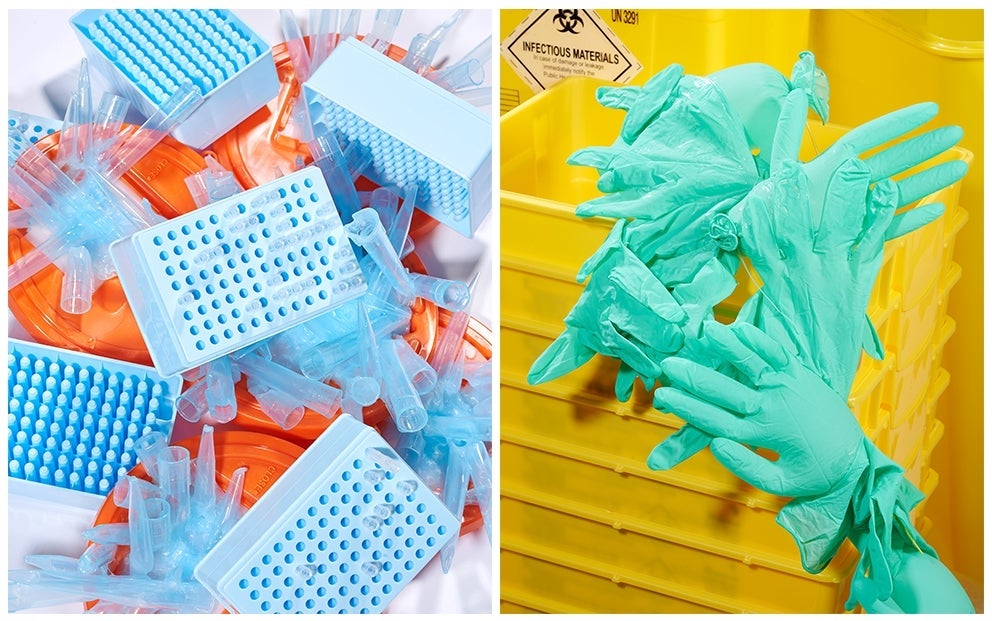
Martin Farley held the first lab sustainability post in the UK, at the University of Edinburgh back in 2013. He now specialises in ways research labs can become more sustainable, working in a similar role to Lewis at a couple of London universities. He first got into the issue because of plastics, but quickly found a whole range of issues to work on.
Farley points out that these ULT freezers can use as much energy as a house. So if you’re worried about energy use in the houses in your street, you should be worried about it in the fridges in your university too. Ultimately, as the climate emergency intensifies, Farley argues, “every facet of society needs to change”.
We have people recycling at home, and doing nothing in their labs. I did a rough back-of-the-envelope calculation. Your impact on the environment is 100–125 times more than at home
Labs might not be a “behemoth” like the oil and gas industry, he says, but they have a significant and often ignored environmental impact. In a research-intensive university, Farley reckons the labs will account for about two-thirds of the energy bill. If a university is looking to reduce its energy use, research sciences are a good place to start.
“We have people recycling at home, and doing nothing in their labs. I did a rough back-of-the-envelope calculation,” he tells me, and, depending on your research area, “your impact on the environment is 100-125 times more than at home”.
* * *
Tracing back through the history of science, it’s hard to tell exactly when disposable plastics arrived in labs. “That’s a job of work to be done, to figure out when plastic starts to get used in scientific instruments, scientific material culture, and how, and how it changes,” says Simon Werrett, a historian at UCL who specialises in the materials of science. He says that there’s plastic in a lot of historical scientific objects, but because museums don’t catalogue items in those terms, it’s hard to date it exactly. Still, he suspects science’s plastic problem followed everyone else’s.
Production of the thing we call plastic started in the late 19th century. Today, we’re increasingly used to seeing plastic as a threat to wildlife, but back then, if anything synthetic products saved nature from being chewed up by human consumption. As the game of billiards became popular, manufacturers looked for a way to produce the balls from something more reliable than the trade in ivory. One firm launched a $10,000 competition to find an alternative material, which led to the patenting of celluloid (a mix of camphor and gun cotton) by American inventor John Wesley Hyatt in 1870.
Hyatt formed the Celluloid Manufacturing Company with his brother Isaiah, and developed a process of “blow-moulding”, which allowed them to produce hollow tubes of celluloid, paving the way for mass production of cheap toys and ornaments. One of the advantages of celluloid was that it could be mixed with dyes, including mottled shades, allowing the Hyatts to produce not just artificial ivory but coral and tortoiseshell too.
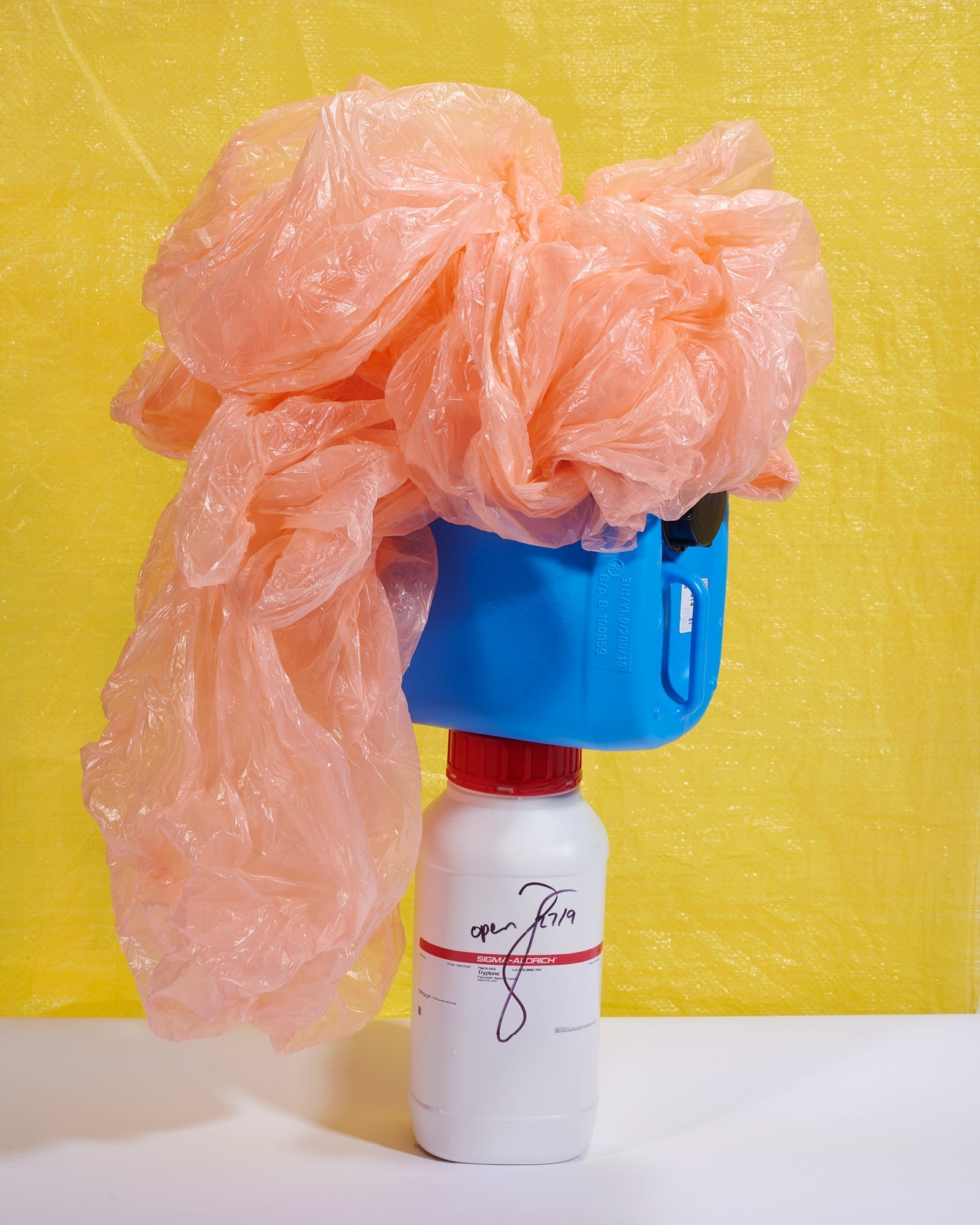
At the turn of the century, the ever-expanding electrical industry was running low on shellac, a resin secreted by the female lac bug which could be used as an insulating material. Spotting a market, Leo Baekeland patented an artificial alternative in 1909, which he named Bakelite. This was marketed in the 1920s as “the material of a thousand uses”, soon joined by a host of new plastics throughout the 1930s and 1940s too. Nylon, invented in 1935, offered a sort of synthetic silk, useful for parachutes and also stockings. Plexiglass was helpful in the burgeoning aviation industry. Wartime R&D put rocket boosters on plastic innovation, and just as plastic products speedily started to fill up the postwar home, a plethora of plastic goods entered the postwar lab, too.
Werrett emphasises that today’s problems are a product not just of plastics but of the emergence of cultures of disposability. We didn’t used to throw stuff away. Disposability pre-dates plastics slightly. Machines of the late industrial revolution, around the middle of the 19th century, made cloth and paper much easier to produce.
At the same time, people were becoming more and more aware, and worried, about the existence of germs – for example, after John Snow identified the Broad Street water pump as the source of a cholera outbreak in Soho, London, in 1854. Just as Joseph Lister pioneered the use of antiseptics in medicine from the 1860s onwards, disposable dressings gradually became the norm. “So you have things like cotton buds, and condoms and tampons, and sticking plasters,” Werrett explains, as well as paper napkins and paper cups. As mass production advanced, it soon became cheaper and easier to throw things away than to clean and reuse them – or pay someone else to.
Cloth- and paper-based disposable products arrived over a relatively short period, but the new throwaway culture they instigated paved the ground for the plastic problem we have today. Paper cups and straws soon became plastic ones, and the idea of “produce, use, discard” became normal.
Still, the introduction of disposable plastics in postwar science and medicine wasn’t necessarily simple. Looking at medical journals from the 1950s and 1960s, Werrett has found a few complaints.
“There’s a tradition that surgeons have a pair of gloves, and they use that for their whole career,” he explains. These gloves would have been rubber – first introduced by William Stewart Halsted at Johns Hopkins Hospital in Maryland in the 1890s – but designed to last, boiled for sterilisation and repaired rather than disposed of in favour of a new pair. “By the end of their career, they’ve got repairs and stains,” Werrett says, “and that’s a sign or mark of your experience as a surgeon.” Then disposable gloves came in, and not everyone was happy to leave these marks of experience behind.
You have to train people to see disposability as a valuable practice
Nurses had to be taught to throw things away, rather than keep them, he notes. “It wasn’t self-evident that disposability was a valuable thing. If anything, the default is to reuse things. You have to train people to see disposability as a valuable practice.”
* * *
For those looking for a plastic-free future for science, a technological fix could well be found in the history. Back in Bristol, Georgina Mortimer has been eyeing up the old glass cabinets. “We’re trying to get back into glassware, trying to make it cool again within our department,” she says, smiling.
In Brussels, Lucy Gilliam tells me about her grandmother, who worked in a hospital lab, and all the dishwashing assistance she had to support their use of glassware. “And now we do it all by ourselves. We’re like little research islands. And you know, plastic – and single-use disposable things – is filling the gap of people.
“There was a time when we were doing really advanced science without using plastics. And it’s not to say that all of the science that we do now can be done without plastics. But there is science that we were doing back then, and that we’re still doing now, that could be done without plastics.”
Plastic has become apparently indispensable for modern science. It can keep materials protected, even when we transport them. It keeps us out of them (for materials we don’t want to contaminate) and them out of us (for hazardous materials that might hurt us). It can be moulded into a range of shapes. Some areas of science – not least DNA research – have grown up in an era of disposable plastics.
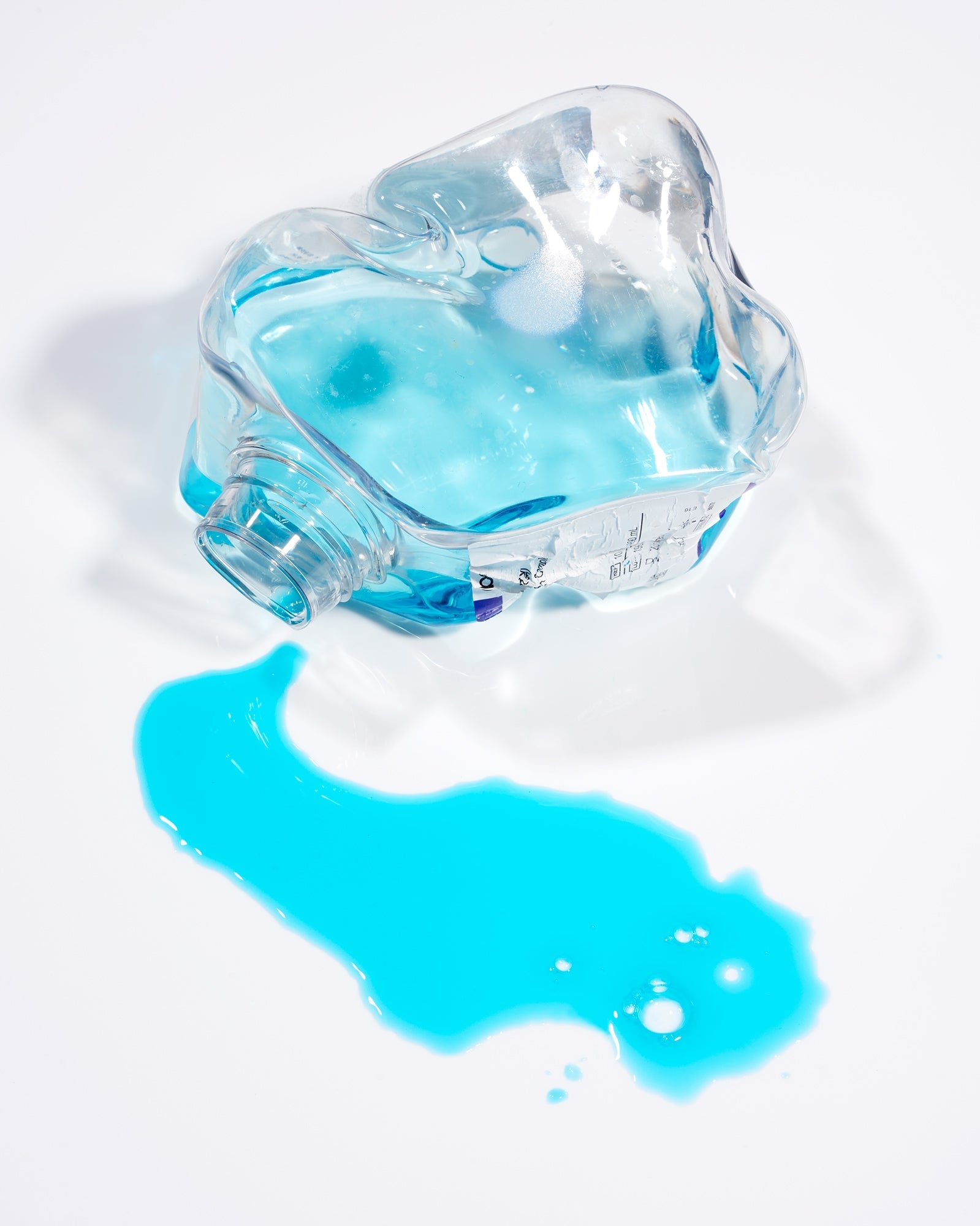
In some cases, though, a return to glass might be the answer. “Use glassware – it’s there, it’s available, it’s sterilised,” Mortimer enthuses. “All the universities will have a glass room just full to the ceilings of stuff that we can be using rather than plastics.” Along with Saranna Chipper-Keating, she has been tasked with producing a whole-life costing exercise on glass versus plastics. In theory, it should be cheaper to reuse glass than to buy plastics again and again, especially as there are often costs associated with dumping these plastics.
But reusing glass means it must be washed and sterilised, and that takes resources, too. This is a concern for Lucy Stuart in Leeds: they don’t want their plastic-free pledge to simply replace one environmental problem with another.
In York, David Kuntin is also concerned about the knock-on effects of switching back to glass. “Every day, we use reagents like cell culture media, a nutrient broth that cells thrive in,” he says. These broths have been developed for decades, and since most cells are grown on plastic, that’s what the reagents have been optimised for.
On top of this, researchers like Kuntin are interested in the finest details of cell behaviour – and what they’re grown on could have an influence. “We know that cells are very responsive to their environment, and they can sense things like the roughness or stiffness of the surface they grow on,” he explains. Unexpected changes in behaviour could be misinterpreted as a consequence of an experiment, when really it’s just that the cells are behaving differently on glass.
Another problem is how much time reusing glass could take. Disposable pipette tips are just quicker. And time, along with water and heat, could cost the lab money. Ultimately, though, they don’t know until they do a full analysis. “We could do a whole-life costing exercise, and it may well be that plastics are so much cheaper,” Anna Lewis says. “In which case, we would need subsidies.”
Lewis argues that any real change will require a change in how science is funded, with universities ideally needing to demonstrate some level of sustainability before they could apply for certain grant schemes. There is only so far they can go working with the goodwill and interest of a few enthusiasts. She sees scope to address this, if not in the next Research Excellence Framework (for assessing the quality of research in the UK) in 2021, then in the one after that. Whether the ecological crisis can wait for us to slowly negotiate yet another decade of science policy is another matter.
* * *
Martin Farley certainly sees a stronger appetite for change from the scientific community, compared to when he first started greening labs, back in 2013. “Five or six years ago, when I told my lab mates I was doing this, people laughed. There was a little bit of interest, like ‘Sure, I’ll recycle more’, and some jokes. Now, I get emails on almost a weekly basis. People out of the blue that are saying, ‘How can I do something? I want to do more.’”
The University of Leeds is keen to link with other organisations, too. They’ve created a network around Leeds, including other universities, the Yorkshire Ambulance Service, the city council and Yorkshire Water. They are also in discussions with one of the national research councils. Stuart says these sorts of collaborations are essential if they want to address disposable plastics on campus, because everything that comes in is part of the broader local economy. But it’s also part of the whole point of the project, seeing themselves as “a civic university”, ensuring that their research and innovation is used in a way that benefits the local area.
For researchers wanting to dive into the problem of plastic waste on their own, though, Gilliam has some simple advice: “First of all, see if you can get some buddies. Send out a note and convene a little meeting. Say, ‘I’ve seen these things, I’m concerned about it, does anybody have any ideas?’” In the event that no one will engage with you, she suggests you just start segregating some of your plastic anyway, putting it in a box and sending it back, sharing a photo on social media as you go. You might well find comrades in other labs if not your own.
“Start by doing something different, even if it feels like it’s really small and really pointless. Even small actions like that can have a ripple effect.”
With thanks to UCL and the Francis Crick Institute for their help with this story. All items photographed are laboratory waste, so no plastic was harmed in this shoot
This article was first published by Wellcome on Mosaic and is republished here under a Creative Commons licence. Sign up to the newsletter at https://mosaicscience.com/newsletter
Join our commenting forum
Join thought-provoking conversations, follow other Independent readers and see their replies
Comments